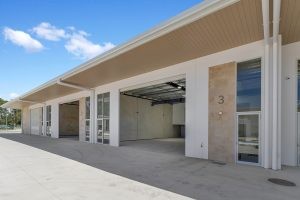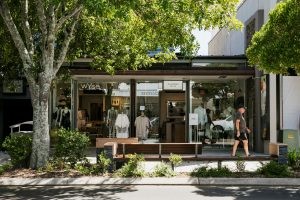The Sunshine Coast is ripe for investors and new commercial property owners to grow and diversify their investment portfolios. As one of Australia’s most vibrant and dynamic markets, the region has demonstrated its ability to hold fairly steady despite significant fluctuations in the national and global economy.
A robust commercial property portfolio offers multiple benefits, including stable rental income and potential for significant capital appreciation.
In a competitive market, it’s the smart and strategic investors who are snapping up the properties with high growth potential. It helps to diversify across both location and asset classes, have flexible options and to think outside the square for current and future uses.
BENEFITS OF HAVING A STRONG COMMERCIAL PROPERTY PORTFOLIO
Investing in commercial property can provide a solid income stream and more financial certainty, especially with longer term leases in place, depending on the type of asset.
Commercial property consultant Josh Harris says there’s still substantial capital growth happening in the coast’s commercial sector.
“Depending on where you are on the coast, we are seeing substantial increases in value especially across the industrial market where the actual value of the land and buildings outweighs the investment yield. Not only are investors earning an income but there’s also potential for strong capital gains,” explains Josh.
Key benefits of building a commercial property portfolio:
- Provides steady rental income
- Potential for capital growth
- Acts as a hedge against economic fluctuations
- Enhances stability through diversification across property types and locations
- Benefits from high demand for commercial spaces on the Sunshine Coast
- Leverages sustained growth driven by a thriving local economy and population influx

THE IMPORTANCE OF DIVERSIFICATION
Diversification is crucial for mitigating risks and improving the chances of returns. By spreading investments across various sectors — such as retail, office, industrial and even residential crossovers — investors can cushion portfolios against market volatility. Consider how you can mix up types of tenants to broaden your cash flow and rental income across various sectors.
Ray White Commercial Noosa & Sunshine Coast Principal Paul Forrest, emphasises the importance of diversification: “By investing in different types of properties and locations, you can reduce exposure to any single market downturn and enjoy more stable returns.”
The value of diversification was clearly seen on the coast during COVID-19 and is evident again now with a downturn in the hospitality sector driven by higher interest rates and cost of living pressures.
“People with diversified portfolios did quite well through the pandemic,” said Josh. “While specific sectors affected by the downturn have struggled to return to pre-pandemic values, anyone with a good spread has seen growth over the last 4-5 years,” Josh said.
“There are ebbs and flows that come with all markets and some are providing higher capital gain with more controlled yield. Diversification across the sectors means people can have solid income coming in while allowing potential capital gain down the track. If one market is struggling, it can be propped up by other sectors.”
Paul Forrest believes there is enough diversity in the Sunshine Coast and broader SEQ market for investors to mix up their portfolio without going further afield.
“Across the local market and surrounds, be it Maryborough, Gympie, Hervey Bay or down to Caboolture, there is enough maturity and diversification for investors – so they don’t really need to go any further. People looking at the sub $5 million market should be able to do their shopping on the Sunshine Coast,” Paul said.

HOW SUNNY COAST INVESTORS ARE MIXING THINGS UP
More local business owners, especially in service businesses and the medical sector, are seeking to become owner occupiers rather than renting commercial properties, especially with the added benefits of purchasing through a self managed super fund and leasing back. This increasing trend is putting pressure on an already tight market and becoming a springboard for new commercial investors who use the equity from that initial property to start building a portfolio.
Demand for industrial property continues to outstrip supply, especially in the sub-150sqm market where people can use the space for business and storage. This is a flow-on from the Covid-related uptick in people buying boats, motorhomes and other items that required extra storage outside home. Buying a shed for personal storage has incentivised building a commercial portfolio after people have had a chance to observe the advantages.
There’s also a growing trend towards traditional and non-traditional uses in industrial zones, with areas like Kunda Park and Forest Glen becoming hubs for diverse business activities.
“We see a move towards mixed-use developments and adaptive spaces that cater to varied business needs,” says David Brinkley. “This shift highlights the region’s evolving commercial landscape and the importance of staying ahead of market changes.”

TIPS FOR GROWING YOUR COMMERCIAL PROPERTY PORTFOLIO ON THE SUNSHINE COAST
- Consider Flexibility and Alternative Use Potential
Commercial property consultant, Adam Morley says approaching each purchase with flexibility in mind can future proof your growth strategy.
“Think about flexibility in design or layout. Look for the ability to section the space up into smaller, tenancies or make it larger for an alternative user with this strategy working best in industrial properties. You might invest in office property but look for alternative uses which may include potential for sports and recreation, showroom, or even the ability to convert to residential,” Adam says.
- Weigh up Cost Benefit of Return And Capital Gain
Evaluate the immediate rental income and long-term property value appreciation. Rental yield provides a steady income stream, while capital gain represents the property’s increased value over time.
“Investors should look for undervalued properties or those with potential for rental rate adjustments and consider the possibility of converting larger commercial spaces into multiple units for higher returns. Balancing these factors, alongside a clear understanding of market trends and goals, can lead to a well-rounded and profitable investment strategy,” says Josh Harris.
- Invest Where There’s Catchment and Infrastructure Growth
Adam suggests seeking out locations that aren’t easily replicated, have limited land availability or that have catchment growth or infrastructure investment.
“Dollars follow dollars,” Adam says. “Invest where other people are spending money, particularly the government. If the government is investing, employment growth is likely to follow. Where there are employment drivers like a new hospital, educational facility or infrastructure project that has ongoing job opportunities, invest in complementary asset classes so you can leverage off infrastructure development and government spending.”
- Always Know the Value of Your Property.
Paul Forrest recommends always being aware of the value of your property.
“You should always know where each property in your portfolio sits in the market and what you can do to improve the property fundamentals like lease structure and rental terms. Sometimes a property is worth more vacant than it is tenanted in this market. Talk to us about that especially if you’re considering selling. Leverage off property value to use the equity you have to build your portfolio and add to the stable.”
- Look for Hidden Upsides
Many people entering the market are chasing returns of 6% or more. However, Commercial Property Agent David Brinkley says properties with a 5% return can offer significant growth in the long term if you sharpen your focus on cap rates and are willing to take on some calculated risk.
“Look for properties that are under-rented, and perhaps have a lease expiry approaching or a market review. For example an industrial property rented at $110-$140 that could see a market rent lift up closer to $180-$200+ per sqm net. If you can buy something showing a 5% return but with a potential uplift in leasing rate increases in the near to mid-term, that’s good buying. Always think of the hidden upside,” David said.
Additionally, consider a property’s potential alternate uses. An existing office in the right area may have the ability to be converted to a residential unit. Buying the commercial office at a price which can achieve a good return is great, but when the time comes to sell you may be able to achieve an even higher sale price repurposed as a residential unit.
- Engage a Professional Property Manager
Engaging a professional property management team you can trust like Ray WhiteCommercial Noosa & Sunshine Coast is essential for building your commercial property portfolio, helping you maximise returns and streamline operations.
A property manager can handle day-to-day operations, ensuring properties are leased, maintained and compliant with regulations. They also provide valuable market insights and strategic advice.
As Paul Forrest points out, “Having a dedicated team ensures your properties are well-maintained and tenants are satisfied, which is crucial for long-term success.”
- Always Have Control of Your Property
Maintaining control over your property, including the ability to make decisions about use and terms, is a fundamental aspect of growing your commercial property portfolio.
“Avoid giving tenants extensive options or long-term leases without flexibility. Keep a mid-term level of control with shorter, more manageable lease terms so you can adapt to changing market conditions and capitalise on any options that may present themselves. And if you are considering giving a tenant a First Right of Refusal in a lease, ensure you have a long discussion with your leasing manager first,” says Paul Forrest.
WHAT TO DO IN THE CURRENT MARKET: WATCH, WAIT OR ACT?
Recent data shows an increase in liquidations and receiverships, surging by 36% in the nine months to the end of March compared to the previous 12 months. As a result we may see some additional commercial properties entering the market, presenting unique opportunities for investors to acquire valuable assets at attractive prices.
But there are always turns in the market. “That’s why we promote the fact you should be conservative in commercial property because you do get vacancies,” says Paul Forrest. “At the moment there are a lot of vacancies in the food industry, a lot of closures. Always have latitude for the unexpected and long vacancies as commercial is not like residential where you can fill multiple vacancies in a week or two.”
Opportunities exist and will continue to arise as the market direction becomes clear, likely through a reduction in interest rates. Yields will be pressured to follow suit. As yields generally track the money market, a downward trend in interest rates will push up capital values, provided cash flow is maintained. By securing properties now, investors can position themselves to benefit from capital gains as the market strengthens.
“In the current market, keeping across what rent rates are, increasing yields on property and hence increasing value of property are sound strategies,” says Paul. “Use that equity to leverage into buying more property. You can still keep a conservative profile while taking advantage of emerging opportunities.”
For chat about your commercial property or the market in general, get in touch with our team on +617 5474 7600.
Offices in NOOSA | CALOUNDRA | MAROOCHYDORE
*Approx.
Subscribe Now

Join the Market Intel community to get exclusive commercial property insights from the Ray White Commercial Noosa & Sunshine Coast North team delivered to your inbox every month:
- Market trends
- Insider tips for investors
- Insights into the local market
Complete the form below to subscribe.



